Reverse Mentoring at Workplace- Nurturing cross- generational Learning
- Ms. Poornima Sehrawat
Abstract-
Reverse mentoring is a process of sharing knowledge between younger-older paradigms. Reverse mentoring is becoming one of the most effective development tools to nurture cross generational learning. This paper focuses on how reverse mentoring concept has brought a paradigm shift in the area of mentoring and transform the knowledge sharing process in the organisation.
Reverse mentoring plays most effective role in bridging the gap between the generations who are currently in the workplace:
Baby Boomers (1946-1964)
Generation -X (1965-1976)
Generation -Y (1977-1998)
These different generations have experienced different social and cultural situations and have different thinking process and different working styles. This paper focuses on how reverse mentoring nurture different generations at workplace and also its benefits at workplace. This paper also focuses on the problems faced by organisations to make reverse mentoring successful.
Keywords-
Mentoring, Reverse Mentoring, Different generations at workplace, Drawbacks of reverse mentoring, learning from reverse mentoring.
Introduction-
“Executives are beginning to realize that knowledge isn’t a one way street. It’s in everyone’s best interest to share expertise.” (Greenguard, 2002)
Reverse mentoring is an opportunity for different generations to increase the learning at workplace. It is a process for informal transmission of knowledge, social capital, and psychosocial support perceived by the recipient as relevant to work, career or professional development (Bozeman and Feeney 2007, P.73
Reverse mentoring upgrades the professionals (Baby Boomers and Generation X) and improve confidence of Generation Y. It is a knowledge sharing process which improves workplace environment and employee engagement.
Reverse Mentoring is an advanced and thrifty professional development tool which nurtures the generational learning.
How to strengthen the mentoring program?
1. Be Purposeful- Management has to understand the purpose behind reverse mentoring and what developmental efforts management can do to make it successful.
2. Learn from the past- What experience mentor and protégé had in the past and how they can overcome the problem.
3. Consider the benefits- Management, Mentor and Protégé has to understand the benefits or after effects of reverse mentoring and review Employee Engagement, Promotion and satisfaction.
4. Be Strategic- How mentoring program will fit into the overall schedule and HR strategies. What is desired culture?
5. Be Bold- How we can create a competitive environment through mentoring.
6. Engage Leaders- What is the best way to engage the leaders which will enhance their leadership quality more?
7. Provide Support- Management should provide support to mentors and protégé in terms of working hours and any other required resources.
8. Adjust quickly- How can we make it better?
(Source: William A. (Bill) Gentry and Richard J. Walsh)
Objective of study-
To understand the basic concept of reverse mentoring.
To study how it nurture the generational learning.
To study how it is important for an organisation.
Table-1:
Reverse Mentoring-
Reverse Mentoring Exchange |
Reverse Mentoring Functions |
Shares technical or Content expertise and enhances understanding of generational trends. |
Career Support Knowledge Sharing |
Provides guidance and feedback on training and mastery of new skills and knowledge. |
Coaching |
Collaboration on projects and research that create contact with each other’s colleagues. |
Exposure and Visibility |
Demonstrates technology savvy and identifies opportunities to apply knowledge. |
Skills Development |
Generates new approaches to problem and suggestions for implementing solutions |
Challenging ideas |
Teaches about social networking sites and social media; Introduces to peers/colleagues to increase social integration and social capital. |
Networking Psychological Support |
Provides support for learning and feedback on new knowledge and skills acquisition. |
Support and Feedback |
Provide support and encouragement that enables mentee/mentor to experiment with new behaviours |
Acceptance and Confirmation |
Collaboration on projects and research that create contact with each other’s colleagues. |
Exposure and Visibility |
Mutual liking and sharing of life events through informal exchange; connecting friends across levels or divisions in the organisation. |
Friendship |
Openly discuss developmental needs and encourage career and personal development. |
Affirmation and encouragement Role Modelling |
Offers fresh perspective on the organisation and its business. |
New Perspective |
Demonstrates openness to new ideas, innovation, and a global perspective. |
Behaviour to emulate |
Shares willingness to learn. |
Identifying with values |
Source: Wandy Marcinkus (2012)Murphy- Reverse Mentoring at Work: Fostering Cross Generational Learning and Developing Millennial Leaders
Literature Review-
According to Dr. Parul Deshwal, “A model has been suggested by Wanberg et al. (2003) for formal traditional mentoring”. There are many difference like, relationship between mentor-protégé can be different it there can be difference in function or in outcomes in terms of mentor outcome, protégé outcome or finally organisational outcome between traditional and modern mentoring are same as a process like sharing knowledge, friendship etc.
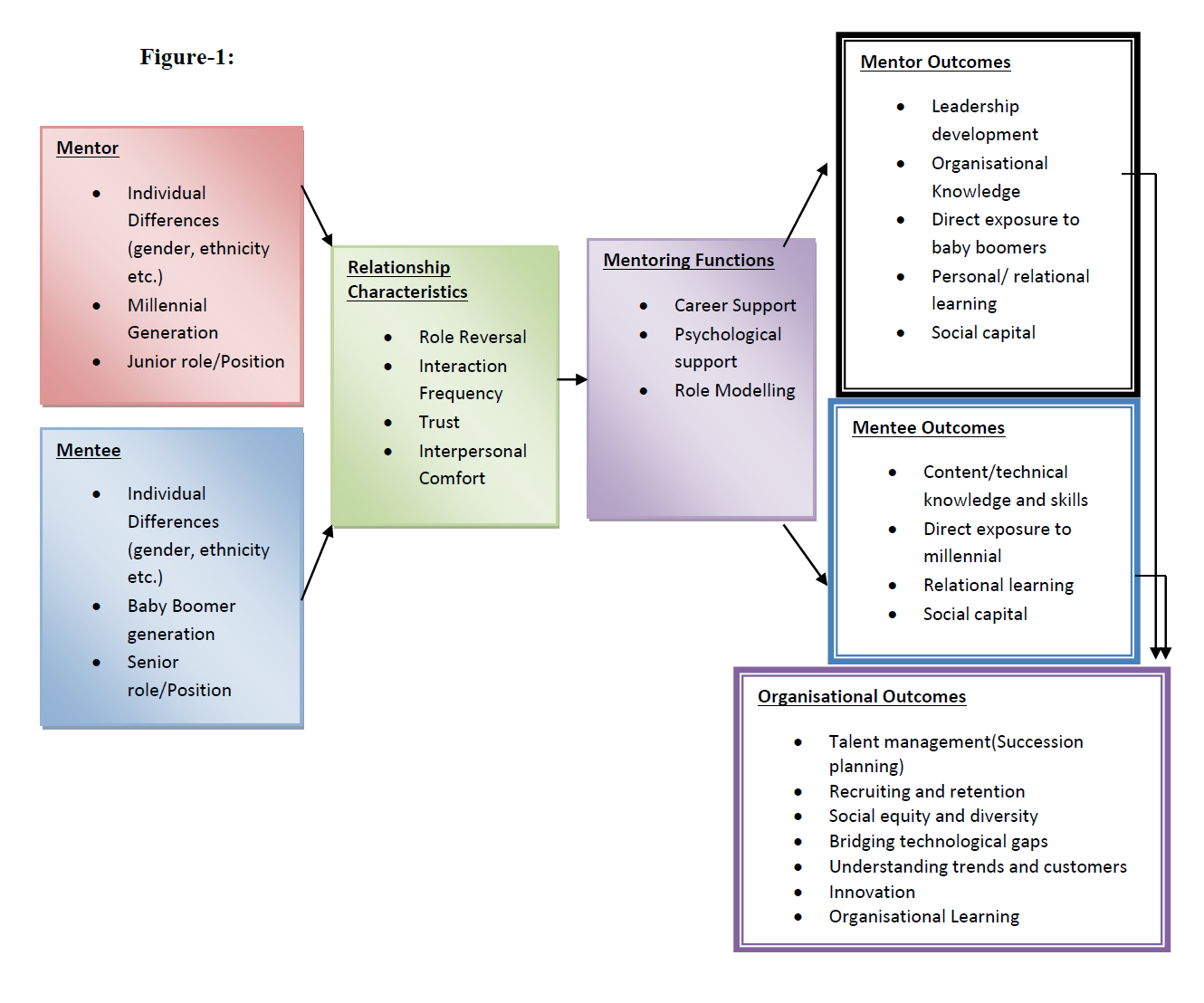
Source: Wanberg et al. (2003) for a comprehensive model of formal, traditional mentoring relationships.
According to Ragins (2002), “Mentor and Mentee who are in mentoring relationship need to understand Intellective and psychical differences in terms of power and diversity in their organisation before they understand the impact of the diversity of their organisation on their mentoring relationship as mentor and protégé.”
Centre of Creative Leadership mentioned that, “Reverse Mentoring improves many aspects in mentees as:-
- Innovation
- Mutual Accountability
- Learning Agility
- Encourage Development Network”
According to Diane Thielfoldt, “Reverse Mentoring is ideal in nature and it is important for employees, manager and an organisation from application of business to smart phone apps. This is also important to learn new market trends and its impact on society and work. Reverse mentoring strengthen the skills of individual who is involved in it. Ex- When people savvy associate paired with manager working on winning over prospective client, everyone can benefit. ”
Anne Morrisan, Janene Piip and Tome Short says, “For workplace mentoring we need to make proper plan and there should be proper communication on to it. Moreover to make reverse mentoring successful there is a need to make every stakeholder commit towards their goal, everybody has to share their roles and responsibilities and there should be a continuous evaluation process.”
Scandura & Ragins says that, “Mentoring has been divided into three categories:
- Career development, including teaching, protection, challenges, exposure and visibility.
- Psychological Support, including acceptance, guidance, consulting, recognition and friendship.
- Role Modelling, including commitment, comparison, trust, respect and demonstration of high standards.”
According to Yin-Che Chen, “Reverse Mentoring not only enhances employee’s professional effectiveness but also the learning standards. According to organisational hierarchy reverse mentoring is beneficial for the reinforcement of employee-management system. Before implementing reverse mentoring program in an organisation, organisation should prepare their employee psychologically to learn new things or to improve knowledge from different generation mentor. There are some other factors which influence reverse mentoring outcome is mentor’s and protégé ‘s personality and their educational backgrounds.”
This policy framework, cognizant of the need for the full ecosystem to be present to unlock entrepreneurial potential, proposes a nine part entrepreneurship strategy:
Wandy Marcinkus says, “Through reverse mentoring million mentors have opportunities to prove them as a good leader through their co-ordination of tasks and maintaining relationship.”
According to Hewlett, S.A., Sherbin,L. & Sumberg,K., “Identically reverse mentoring discussed between Gen Y and Baby boomers mentoring relationship. They are different in demographic trends, content and technological expertise. ”
Deloitte Report says, “Reverse mentoring is different from traditional mentoring in which junior one becomes mentor and senior of any organisation become protégé and they share information and keep protégé upgrade. It is also beneficial for mentor with improving the confidence & leadership quality of millenniun. Reverse Mentoring is an excellent way to make them realize that what qualities they have and what they can do in future.
Reverse mentoring also give beneficial to senior executive by improving their technical knowledge and keep them up to date. It increase engagement and reduce conflict and attrition rate of millenniun. ”
Research Methodology –
Collection of Data- The data was primarily collected by survey method from (Gen-Y) as a mentors and Baby Boomers and Gen X as mentees using convenience sampling method and also finds out correlation between both mentor and mentee data.
Sample Size and technique-
Besides secondary data, the primary data was collected by using questionnaire and the questions were close ended and Likert scale based which were coded according to the objective of the study.
Sample size is 30 for Gen Y as mentors and 36 for Generation X and Baby boomers.
Convenience method was adopted to find out that how reverse mentoring works and how it nurtures the different generational learning. This method helps us to find out what challenges mentor and mentees are facing during reverse mentoring.
Also used statistical tool correlation to find out the effectiveness of reverse mentoring.
Factors affected by reverse mentoring
Table-2- According to Protégé (Baby Boomers and Gen X)
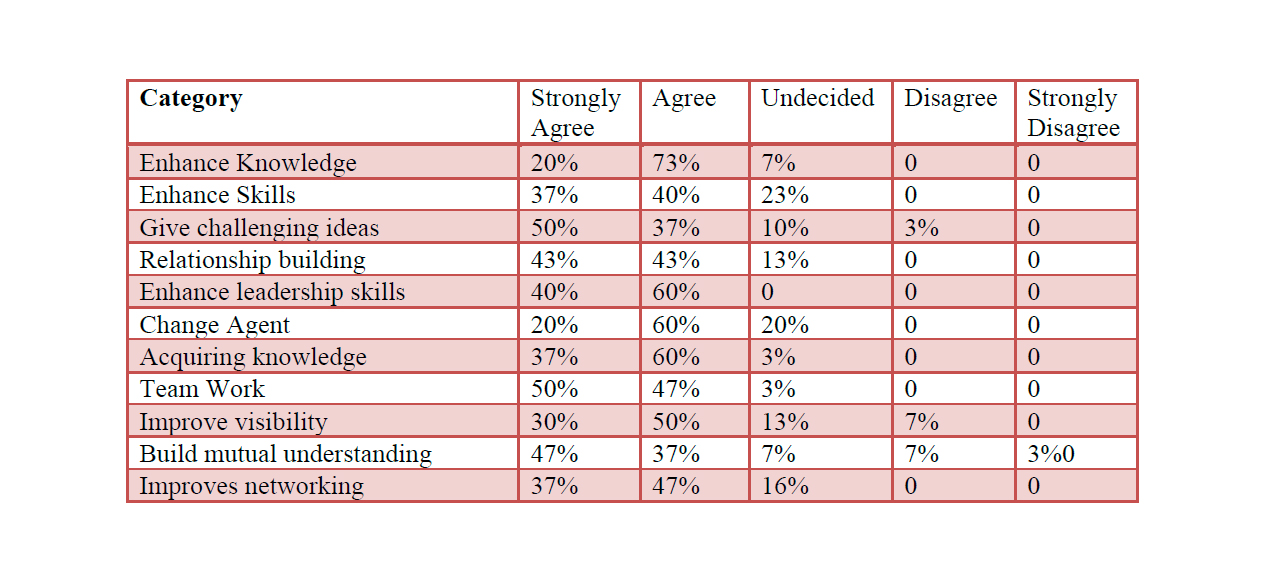
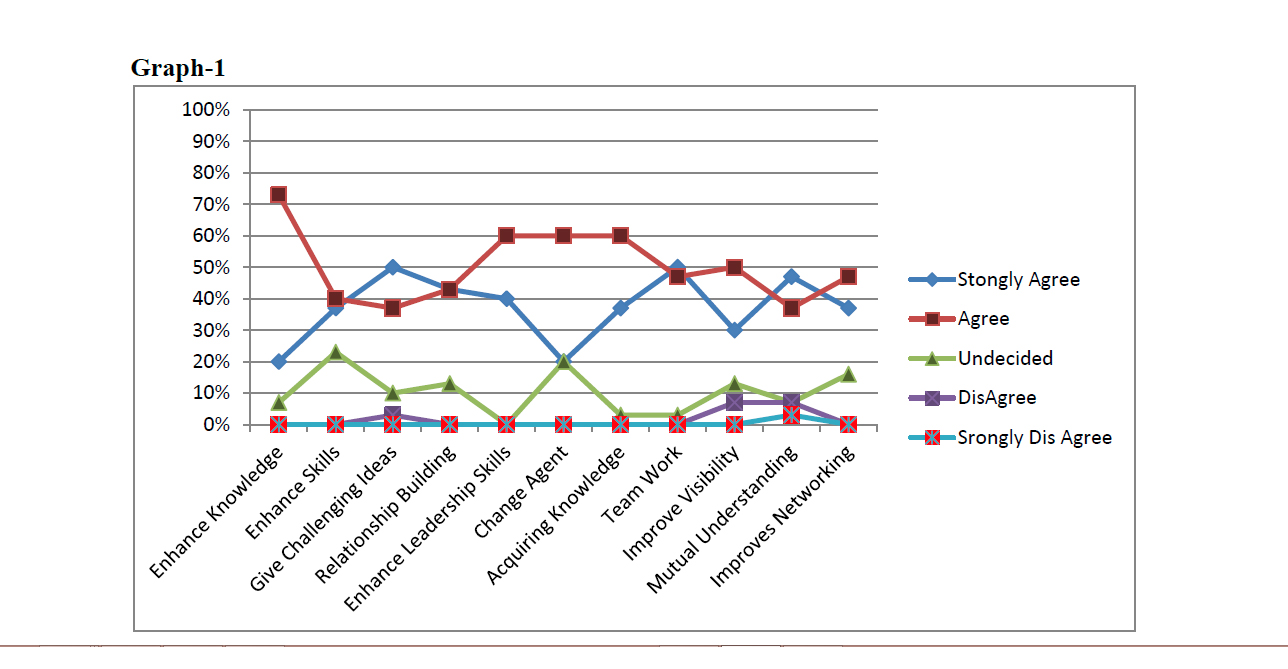
Findings-
According to the survey and as per Table-2 and Graph-1 of Mentees (Gen X and Baby Boomers) regarding reverse mentoring and how it nurtures them and how it is beneficial to make them technology-savvy and keep them upgrade.
94.4% respondent mentioned that reverse mentoring enhance knowledge.
88.8% respondent mentioned that reverse mentoring enhance skills.
83.3% respondent mentioned that reverse mentoring mutual understanding.
77.7% respondent mentioned that reverse mentoring give challenging ideas.
88.8% respondent mentioned that reverse mentoring improve visibility
Table-3- According to Mentor (Gen Y)
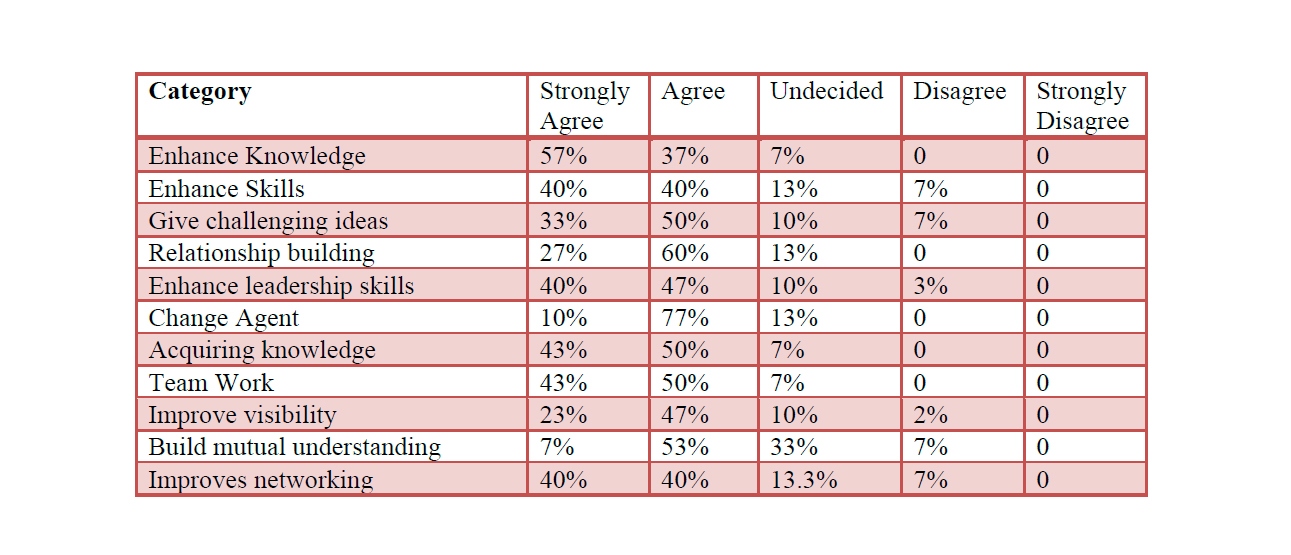
Graph-2
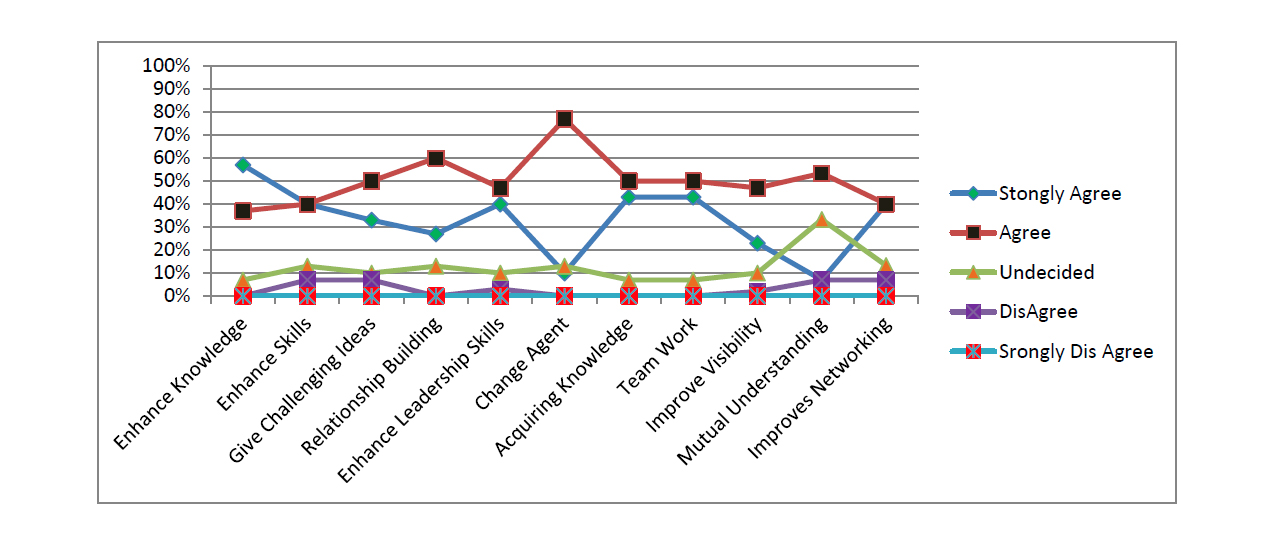
Findings-
According to the survey and as per Table-3 and Graph-2 of Mentors (Gen Y) regarding reverse mentoring and how it is beneficial for them to improve their leadership skills and build their confidence.
73.3% respondent mentioned that reverse mentoring is a change agent in change management.
86.7% respondent mentioned that reverse mentoring enhance skills.
79.9% respondents mentioned that reverse mentoring enhance leadership skills.
60.1 % respondent mentioned that reverse mentoring mutual understanding.
80% respondent mentioned that reverse mentoring give challenging ideas.
73.2% respondent mentioned that reverse mentoring improve visibility.
Results-
In the primary analysis on reverse mentoring between mentor and protégé we find out some factors highly significant as factor Improve networking (0.735) has significance in reverse mentoring, factor leads mutual understanding of generation (0.475) is significant and factor Enhance leadership skills (0.297) is also significant in reverse mentoring.
Table-4: Significance between mentor and protégé:
Factors |
Significance Value |
Enhance Knowledge Sharing |
.017 |
Enhance Skills |
.045 |
Give more challenging ideas |
.000 |
Work as catalyst in relationship building |
.12 |
Enhance Leadership Skills |
.297 |
Act as change agent in change management |
.016 |
Contribution in acquiring knowledge |
.014 |
Improve team work |
.046 |
Give exposure and improve visibility |
.030 |
Leads mutual understanding of generation |
.475 |
Improve networking |
.735 |
Table-5: Correlation between mentor and protégé:
According to analysis between mentor and protégé on different factors some factors are highly correlated like give more challenging ideas (r = 0.610), some are moderate correlated as Work as catalyst in relationship building (r = 0.455), Contribution in acquiring knowledge (r = 0.444), Act as change agent in change management (r =0.437), Enhance knowledge sharing (r = 0.432). All factors correlation shown in Table-5.
Factors |
r |
Enhance Knowledge Sharing |
.432* |
Enhance Skills |
.369* |
Give more challenging ideas |
.610** |
Work as catalyst in relationship building |
.455* |
Enhance Leadership Skills |
.197# |
Act as change agent in change management |
.437* |
Contribution in acquiring knowledge |
.444* |
Improve team work |
.368* |
Give exposure and improve visibility |
.397* |
Leads mutual understanding of generation |
.136# |
Improve networking |
.064# |
Notes: *p < 0.05; **p<0.01; # not significant |
|
Conclusion-
Reverse mentoring plays an important role in sharing knowledge and trends between different generations. It helps Baby boomers and Gen X in upgrading them in terms of technology and it also helps Generation Y to improve their confidence. Reverse mentoring had positive effects on career development, psychological support and role modelling. It gives more challenging ideas to mentor as well as protégé. Reverse mentoring improves team work between mentor and protégé.
Reverse mentoring keeps engage Generation Y and make baby boomers upgrade. Generation Y make them tech savvy and train them with new technology and trends to keep them upgrade so that they also feel confident with new technology. This creates a positive work environment in an organisation where knowledge has been shared for the betterment of employees. This study is limited to Pune city only; this can expand all over India to do more elaborative study.
References-
1. Anne Morrisan, Janene Piip and Tom Short, “Workplace mentoring revisited: formal or just smart casual?”, Journal- 21st National vocational education and Training Research conference, pp. 92.
2. Centre of Creative leadership, pp. 15.
3. Diane Thielfoldt, “Mentoring from the bottom up, how and why to do it yourself with cross generational mentoring program”, Part-1.
4. Dr. Parul Deshwal, “Creating a new mindset: Reverse Mentoring”, IJSRM, Vol. 3, issue, 10th Oct, 2015, pp. 3622.
5. Deloitte Report, “Reverse Mentoring”, 2015, pp-1-2.
6. Hewlett, S.A, Sherbin, L. & Sumberg, K. (2009 a), “How Gen Y and Boomers will reshape your agenda”, Harward business review, 8 (7/8), pp. 71-76.
7. Hewlett, S.A, Sherbin, L. & Sumberg, K. (2009 a), “Let Gen Y teach you tech. Retrived from “http://blogs.harwardbusiness.org/hbr/hewlwtt/2009/06/let_gen_Y_teach_you_tech.html”
8. Ragins B.R, 2002, “understanding diversified mentoring relationships: definition, challenges & strategies in mentoring and diversity”, an international perspective, eds D clutterbuck & B R Ragins, butter-worth-heinemann, Oxford, pp. 23-53.
9. Scandura, T.A. and Ragins, B.R. (1993), “The effects of sex and gender role orientation on mentorship in male dominated organisation.”, J. Vocat. Behav., 43(3), pp. 251-265.
10. Wendy Marcinkus Murphy, “Reverse Mentoring at work forstering cross-generational learning and develop millennial leaders”, J-HRM, July-August, 2012, Vol. 51, No. 4, pp. 552-553.
11. Yin Chan Chen, “Effect of reverse mentoring on traditional mentoring function”, J. Leadership & Management in Engineering, July. 2013, pp. 206-207.

